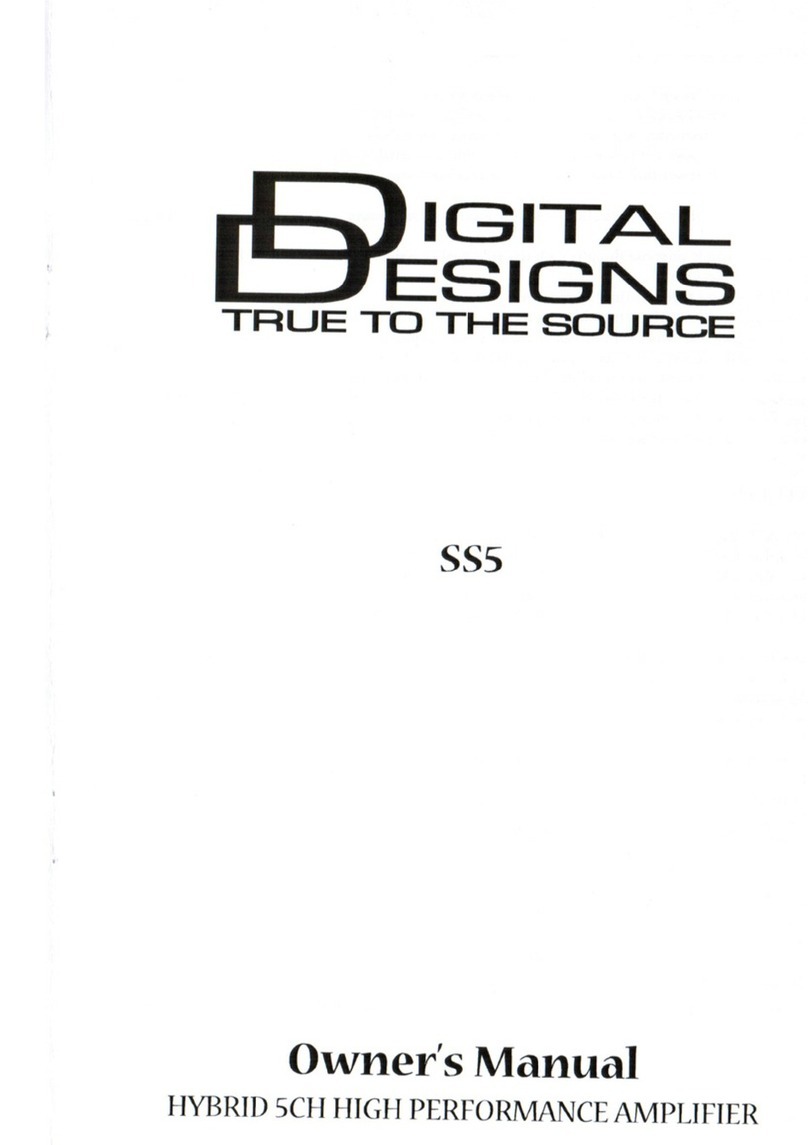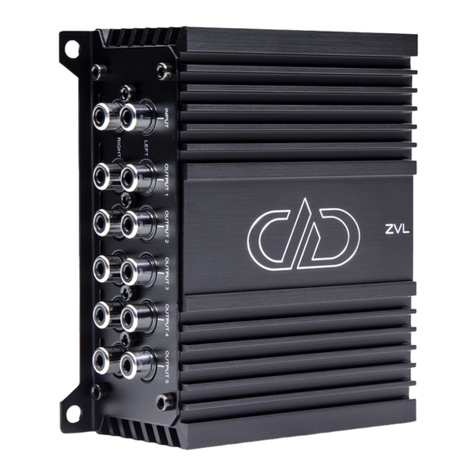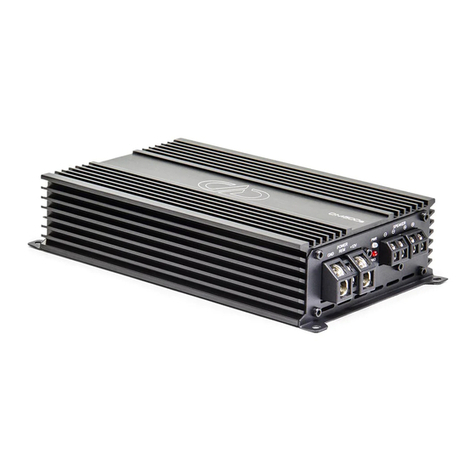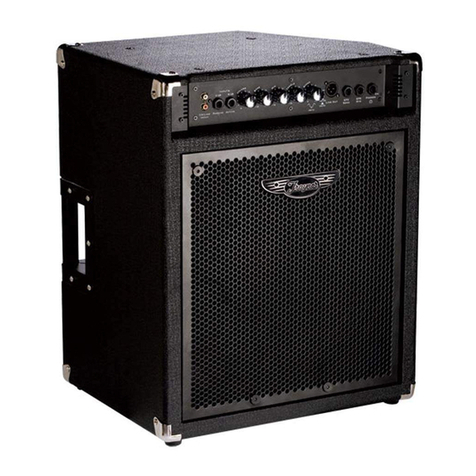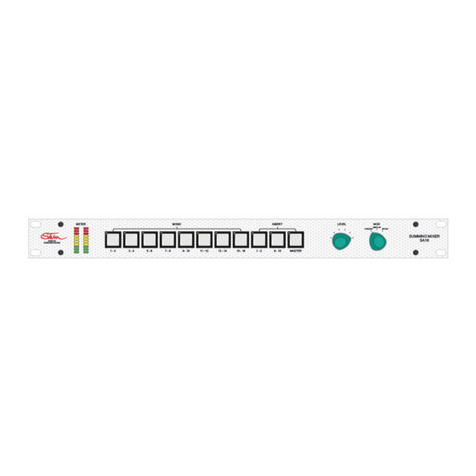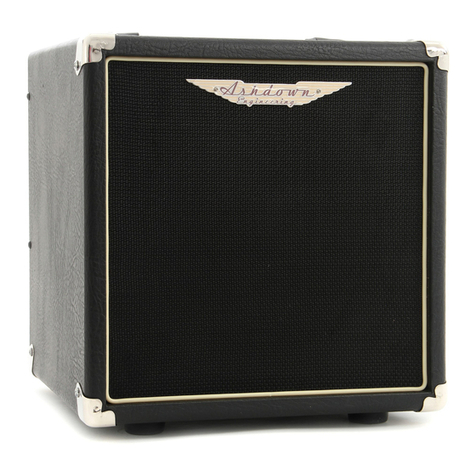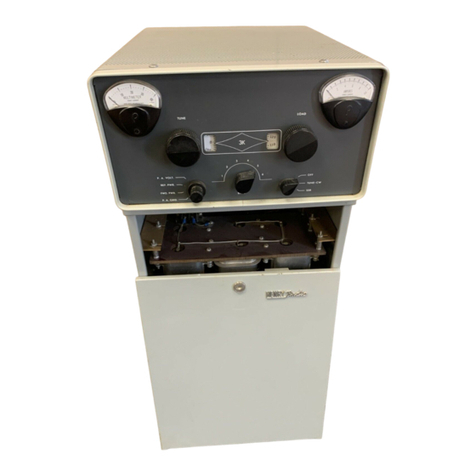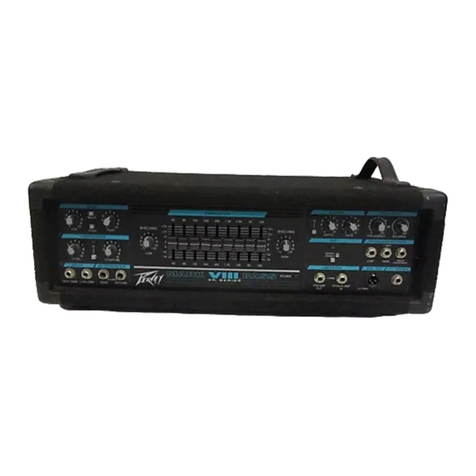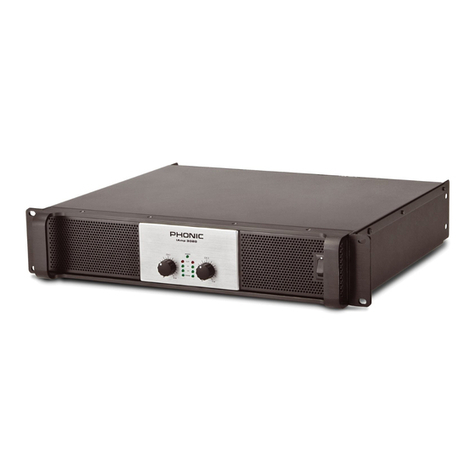DD Audio DM1500 User manual

OWNER’S MANUAL
DM1500, DM2500
CLASS D
MONOBLOCK AMPLIFIER

DD AUDIO / CLASS D MONOBLOCK AMPLIFIER /1
Thank you for purchasing a DD Audio amplifier. DD Audio amplifiers are
painstakingly designed to provide years of high-performance listening
pleasure. To achieve optimum performance we suggest you have your
amplifier installed by an Authorized DD Audio Dealer. It is also highly
recommended that you read this Owner's Manual to familiarize yourself
with the many features of your amplifier.
The DM Series contains monoblock amplifiers. These amps are
engineered specifically for low frequency car audio reinforcement.
Designed with the goal of being the best amps on the market for
everyone from the everyday enthusiast to the hardcore competitor.
The DM Series will be the soul of your audio system delivering clean,
powerful audio. These amps feature compact chassis, strong power,
logical controls and efficient design. No shortcuts were taken when
deciding on the internal components and feature sets. Our engineers
paid extremely close attention to every stage of the DM Series circuit
design; and utilized high speed controller chipsets, efficient power
devices, precise thermal management and the latest in IC technology.
We hope you enjoy using this DD Audio product, and if you have any
questions regarding setup or installation, please contact the DD Audio
technical support team.
INTRODUCTION

WARNING
DD Audio amps are built to play at high volumes beyond
what your ears can safely handle for extended periods of
time. Prolonged exposure to excessively high volume
can cause permanent damage to your hearing.
In addition, operation of a motor vehicle while
listening to audio equipment at high volume levels may impair your ability
to hear external sounds such as: horns, warning signals, or emergency
vehicles; thus, constituting to a potential traffic hazard. You may also find
your state has laws governing the volume of an audio system in a car.
Please be aware of all local and state laws in your area. So, be smart,
and behave yourself… As much as possible.
DM1500 & DM2500 SERIES DESIGN FEATURES:
• MOSFET POWER SUPPLY AMPLIFIER
• 0 GAUGE POWER TERMINALS
• 10 GAUGE SPEAKER LEAD TERMINALS
• DOUBLE SIDED THROUGH HOLE PCB
• VARIABLE 24dB/oct. CROSSOVERS
• STRAPPABLE CONNECTION
• REMOTE SUBWOOFER CONTROL: DASH MOUNT CONTROL
WHICH ALLOWS CONVENIENT LEVEL CONTROL, MONITORING
OF BATTERY VOLTAGE, AND CLIPPING INDICATOR
• 6-WAY PROTECTION: CLIPPING LIMITER, SPEAKER SHORT,
THERMAL, OVERLOAD, HI/LOW VOLTAGE, DC OFFSET
• 12~16V WORKING VOLTAGE
DD AUDIO / CLASS D MONOBLOCK AMPLIFIER /2

TECHNICAL SPECIFICATIONS
DD AUDIO / CLASS D MONOBLOCK AMPLIFIER / 3
DM1500 DM2500
1 1
581 813
1006 1413
1583 2503
2300 3000
230A 300A
15~200Hz 15~200Hz
>85dB >85dB
>150 >150
4V - 0.1V 4V - 0.1V
Y Y
0 0
10 10
13.5x7x2 18x7x2
340x175x55 450x175x55
Test Voltage
14.4V
Channels
Continuous
Wattage
4Ohm
2Ohm
1Ohm
Dynamic Wattage
Maximum
Current Draw
Frequency
Response
S/N Ratio
Damping Factor
RCA Input
Voltage
Sensitivity
Remote
Subwoofer
Control
Power Wire
Gauge In
Speaker Wire
Gauge Out
Dimensions: in
Dimensions: mm

PRE-AMP PANEL
INPUT:
Used for connecting RCA preamp
signal cables from the source unit to
the amplifier.
PWR LED:
Indicates the amplifier is grounded,
and receiving +12V and REM power.
PRO LED:
Indicates a general malfunction due
to speaker short, faulty connection or
thermal protection.
GAIN:
Matches the output voltage of the
source signal to the amplifier’s
input section.
SUBSONIC:
Controls the high pass cutoff point for
the speaker outputs. This helps to
eliminate extremely low frequencies
that can waste amplifier power and
cause damage to your subwoofers.
REMOTE:
This port is for connecting the remote
subwoofer control.
LPF:
Controls the low pass cutoff point for
the speaker outputs.
OUTPUT MASTER/ INPUT SLAVE:
This switch enables the STRAP or
LINK function when connecting two or
more DM SERIES amplifiers.
IN:
Used when Strapping or Linking DM
Series amplifiers. Connects to the
OUT RCA terminal.
OUT:
Used when Strapping two DM
SERIES amplifiers. Connects to the
IN RCA terminal.
GND:
Connect to a ground wire going
directly to the chassis of your
vehicle. Minimum cable size is
0 gauge.
REM:
Connect to a switched +12V
cable.
+12V:
Connect to a fused positive cable
(+12V) from the battery. Minimum
power cable size is 0 gauge.
SPEAKER OUTPUT TERMINALS:
Connect to the speaker's + and -
terminals. Minimum suggested
speaker cable size is 12~10 gauge.
DM Series amplifiers have two + and
two - terminals for easier connection
of multiple speaker cables. Minimum
impedance is 1 ohm.
DD AUDIO / CLASS D MONOBLOCK AMPLIFIER / 4
CONTROL AND CONNECTION FOR
DM SERIES AMPLIFIERS

POWER PANEL
INPUT:
Used for connecting RCA preamp
signal cables from the source unit to
the amplifier.
PWR LED:
Indicates the amplifier is grounded,
and receiving +12V and REM power.
PRO LED:
Indicates a general malfunction due
to speaker short, faulty connection or
thermal protection.
GAIN:
Matches the output voltage of the
source signal to the amplifier’s
input section.
SUBSONIC:
Controls the high pass cutoff point for
the speaker outputs. This helps to
eliminate extremely low frequencies
that can waste amplifier power and
cause damage to your subwoofers.
REMOTE:
This port is for connecting the remote
subwoofer control.
LPF:
Controls the low pass cutoff point for
the speaker outputs.
OUTPUT MASTER/ INPUT SLAVE:
This switch enables the STRAP or
LINK function when connecting two or
more DM SERIES amplifiers.
IN:
Used when Strapping or Linking DM
Series amplifiers. Connects to the
OUT RCA terminal.
OUT:
Used when Strapping two DM
SERIES amplifiers. Connects to the
IN RCA terminal.
GND:
Connect to a ground wire going
directly to the chassis of your
vehicle. Minimum cable size is
0 gauge.
REM:
Connect to a switched +12V
cable.
+12V:
Connect to a fused positive cable
(+12V) from the battery. Minimum
power cable size is 0 gauge.
SPEAKER OUTPUT TERMINALS:
Connect to the speaker's + and -
terminals. Minimum suggested
speaker cable size is 12~10 gauge.
DM Series amplifiers have two + and
two - terminals for easier connection
of multiple speaker cables. Minimum
impedance is 1 ohm.
DD AUDIO / CLASS D MONOBLOCK AMPLIFIER / 5
CONTROL AND CONNECTION FOR
DM SERIES AMPLIFIERS

STRAP MODE CONNECTION
Strap Mode allows the connection of two pieces of the same DM SERIES
amplifier. In STRAP Mode the MASTER amplifier’s pre-amp settings will control
the audio signal for both amplifiers. The outputs of both amps will work as a
single output section. The minimum speaker impedance in STRAP mode should
be 2Ohm. Please follow the instructions and diagram carefully for the correct
connection method.
1. Connect the master amplifier to the head-unit and set its OUTPUT MASTER/INPUT
SLAVE switch to the OUTPUT MASTER position.
2. Set the SLAVE amplifier’s OUTPUT MASTER/INPUT SLAVE switch to the INPUT
SLAVE position.
3. Connect the MASTER and SLAVE amplifiers via the IN and OUT RCA jacks as shown
in the diagram.
4. Connect SPEAKER terminal ( + ) of MASTER amplifier to subwoofer ( + ) lead wire.
5. Connect SPEAKER terminal ( + ) on SLAVE amplifier to subwoofer ( - ) lead wire.
6. Connect SPEAKER terminal ( - ) on MASTER amplifier to SPEAKER terminal ( - ) on
SLAVE amplifier.
DD AUDIO / CLASS D MONOBLOCK AMPLIFIER / 6
Set Master amp’s mode
switch to Master
Set Slave amp’s mode
to INPUT Slave
Master Amp
Slave Amp

STRAP MODE CONNECTION (Continued)
DD AUDIO / CLASS D MONOBLOCK AMPLIFIER / 7

MOUNTING YOUR AMPLIFIER
POWERING YOUR AMPLIFIER
Make sure your vehicle’s charging system is adequate
for the amplifier you’re installing. Amplifiers don’t make
power, they simply convert the current and voltage you
give them into wattage. If your charging system is
insufficient, your amp will not produce its full rated output. If the current
or voltage supply drops too low, even for milliseconds, damage can be
caused resulting in amplifier failure. This type of failure is not considered
a manufacturer's defect. The addition of even a small amplifier will
increase the demand on your charging system. If you are unsure or have
questions about your charging system, have it tested by a professional
technician to determine its capability.
DD AUDIO / CLASS D MONOBLOCK AMPLIFIER / 8
• Mount your amplifier in a dry, well-ventilated environment.
• Before mounting the amplifier be sure the mounting location and
screw placement will not present a hazard to any cables, wiring,
fuel lines, fuel tanks, hydraulic lines or other vehicle systems or
components.
• Securely mount the amplifier using appropriate hardware so that it
does not come loose in the event of a collision or a sudden jolt to
the vehicle.
• Do not mount the amplifier to any area that may have excessive
vibration (like the subwoofer box).
• Take into consideration your vehicle’s safety equipment (air bags,
seat belt systems, ABS brake systems, etc.) and avoid interfering
with such equipment.

1. Disconnect the negative cable from the car battery.
2. Due to the power requirements of the Amplifier, the +12V
connection should be made directly to the positive (+)
terminal of battery. For safety measures, install an in-line
fuse holder (not included) as close to the battery’s positive (+)
terminal as possible . The fuse ampere rating should not exceed the total
value of the amplifier’s rated maximum current draw. If the fuse is further
than 18 inches (wire length) from the battery you should re-evaluate the wire
and fuse placement.
Run the power wire from the battery to the amplifier. To avoid a potential
short to the body and a possible fire, this cable should never be ran outside
of the vehicle. You will also need to make sure no trim screws or sharp body
metal will penetrate the power cable shielding. Don’t install the fuse yet. This
will be the last thing you do.
3. Connect the ground wire directly to the chassis of your vehicle. The
grounding location should be made on metal as close to the amplifier as
possible. Remove all paint, sound deadener, etc. from the area of grounding
connection. Do not use seat belt bolts for grounding. It is advisable to test the
ground with an ohmmeter. Test between the grounding point and the negative
battery cable to insure a good low resistance connection (<0.5 Ohm).
4. Run the REM Turn-On wire from the an ignition controlled +12V source. This
will turn “ON” the amplifier remotely when the vehicle’s stereo is turned “ON”.
NOTE IF YOUR RADIO DOES NOT HAVE A +12 VOLT OUTPUT LEAD
WHEN THE RADIO IS TURNED ON, THE AMPLIFIER CAN BE
CONNECTED TO AN ACCESSORY CIRCUIT IN THE VEHICLE THAT IS
LIVE WHEN THE KEY IS “ON”.
5. Run the RCA cables if they will be used for the application or make your
high-level signal connections.
5. Run the speaker wire to the speakers. It is advised that you leave some extra
wire at this point. You can “clean it up” later.
6. Connect the power and ground to the amplifier. Make sure the polarity (+ and
-) is correct to avoid damaging the amplifier. Only after this step should you
install the fuse at the battery.
7. Connect the remote wire from the head unit to the amplifier. At this time you
should turn on the amp and make sure it turns on properly and does not go
into protect.
DD AUDIO / CLASS D MONOBLOCK AMPLIFIER / 9
INSTALLATION
8. Turn the amp off and connect the speaker wire to the amp. Pay attention to
the polarity (+ and-). If hooked up incorrectly it can cause poor sound due to
phasing issues.
9. Connect the RCA cables or high-level harness to the amp.
10. Double check the amplifier controls to verify they are set correctly for your
system.
11. Now you can turn on the system and begin the fine tuning process. Turn the
amp gain all the way down. Turn the head unit volume to somewhere
around 75%.
12. Now you can tune the amp. Take your time and make only one adjustment at
a time. It may take some time to get the system fully adjusted. During this
time the amp is drawing current from the battery. You should check the
battery voltage from time to time and re-charge it if it gets low. Battery voltage
can affect the way the amplifier performs.
13. You may have to do some slight re-tuning at a later date if you are installing
new speakers at the same time as the amp due to the speakers breaking in.

1. Disconnect the negative cable from the car battery.
2. Due to the power requirements of the Amplifier, the +12V
connection should be made directly to the positive (+)
terminal of battery. For safety measures, install an in-line
fuse holder (not included) as close to the battery’s positive (+)
terminal as possible . The fuse ampere rating should not exceed the total
value of the amplifier’s rated maximum current draw. If the fuse is further
than 18 inches (wire length) from the battery you should re-evaluate the wire
and fuse placement.
Run the power wire from the battery to the amplifier. To avoid a potential
short to the body and a possible fire, this cable should never be ran outside
of the vehicle. You will also need to make sure no trim screws or sharp body
metal will penetrate the power cable shielding. Don’t install the fuse yet. This
will be the last thing you do.
3. Connect the ground wire directly to the chassis of your vehicle. The
grounding location should be made on metal as close to the amplifier as
possible. Remove all paint, sound deadener, etc. from the area of grounding
connection. Do not use seat belt bolts for grounding. It is advisable to test the
ground with an ohmmeter. Test between the grounding point and the negative
battery cable to insure a good low resistance connection (<0.5 Ohm).
4. Run the REM Turn-On wire from the an ignition controlled +12V source. This
will turn “ON” the amplifier remotely when the vehicle’s stereo is turned “ON”.
NOTE IF YOUR RADIO DOES NOT HAVE A +12 VOLT OUTPUT LEAD
WHEN THE RADIO IS TURNED ON, THE AMPLIFIER CAN BE
CONNECTED TO AN ACCESSORY CIRCUIT IN THE VEHICLE THAT IS
LIVE WHEN THE KEY IS “ON”.
5. Run the RCA cables if they will be used for the application or make your
high-level signal connections.
5. Run the speaker wire to the speakers. It is advised that you leave some extra
wire at this point. You can “clean it up” later.
6. Connect the power and ground to the amplifier. Make sure the polarity (+ and
-) is correct to avoid damaging the amplifier. Only after this step should you
install the fuse at the battery.
7. Connect the remote wire from the head unit to the amplifier. At this time you
should turn on the amp and make sure it turns on properly and does not go
into protect.
DD AUDIO / CLASS D MONOBLOCK AMPLIFIER / 10
INSTALLATION (continued)
8. Turn the amp off and connect the speaker wire to the amp. Pay attention to
the polarity (+ and-). If hooked up incorrectly it can cause poor sound due to
phasing issues.
9. Connect the RCA cables or high-level harness to the amp.
10. Double check the amplifier controls to verify they are set correctly for your
system.
11. Now you can turn on the system and begin the fine tuning process. Turn the
amp gain all the way down. Turn the head unit volume to somewhere
around 75%.
12. Now you can tune the amp. Take your time and make only one adjustment at
a time. It may take some time to get the system fully adjusted. During this
time the amp is drawing current from the battery. You should check the
battery voltage from time to time and re-charge it if it gets low. Battery voltage
can affect the way the amplifier performs.
13. You may have to do some slight re-tuning at a later date if you are installing
new speakers at the same time as the amp due to the speakers breaking in.

DD AUDIO / CLASS D MONOBLOCK AMPLIFIER / 11
TROUBLESHOOTING:
NO POWER
• Check GND connection.
• Check voltage at the amplifier’s +12V and REM terminals.
• Check fuses.
NO SOUND ( NO OUTPUT )
• Check all cable routing for shorts or faulty connections,
• Check speakers to verify they are in proper operating condition.
• Check all amplifier controls to ensure they are set properly.
(Gain, Crossovers, Master/Slave Switch)
PROTECTION
• Possible causes overheat (thermal), short.
• If the amplifier shuts down due to overheating, it will automatically return to
normal. operation once the amplifier temperature drops below the thermal
shutoff temperature. Make sure there is proper airflow with no obstructions
around the amplifier to avoid further.
• Thermal protection. In some cases an external fan may be required to keep
the amplifier temperature below the thermal protect level.
• The DM-Series working voltage is 9V - 16V. When voltage is lower than 8.5V
or higher than 16V the amplifiers will not operate correctly.
DISTORTION
• Check speaker cables for reverse polarity of one channel.
POOR BASS RESPONSE
• Check speaker cables for reverse polarity of one channel.
BUZZING SOUND
• Check the amplifier and headunit ground connections.
• Check RCA cable connections and possibly replace RCA cables with better
noise shielded cable or reroute RCA cables away from power cables.
WHINING NOISE
• Engine noise can be caused by poor grounding of amplifiers, headunits,
signal processors, battery or alternator. If you can remove the signal cables
from the amplifier and the noise goes away the sound is not being generated
by your amplifier, but by an external grounding issue.
If you have any questions regarding setup, installation or warranty please contact
phone at (405) 239-2800.

NO POWER
• Check GND connection.
• Check voltage at the amplifier’s +12V and REM terminals.
• Check fuses.
NO SOUND ( NO OUTPUT )
• Check all cable routing for shorts or faulty connections,
• Check speakers to verify they are in proper operating condition.
• Check all amplifier controls to ensure they are set properly.
(Gain, Crossovers, Master/Slave Switch)
PROTECTION
• Possible causes overheat (thermal), short.
• If the amplifier shuts down due to overheating, it will automatically return to
normal. operation once the amplifier temperature drops below the thermal
shutoff temperature. Make sure there is proper airflow with no obstructions
around the amplifier to avoid further.
• Thermal protection. In some cases an external fan may be required to keep
the amplifier temperature below the thermal protect level.
• The DM-Series working voltage is 9V - 16V. When voltage is lower than 8.5V
or higher than 16V the amplifiers will not operate correctly.
DISTORTION
• Check speaker cables for reverse polarity of one channel.
POOR BASS RESPONSE
• Check speaker cables for reverse polarity of one channel.
DD AUDIO / CLASS D MONOBLOCK AMPLIFIER / 12
TROUBLESHOOTING (continued):
BUZZING SOUND
• Check the amplifier and headunit ground connections.
• Check RCA cable connections and possibly replace RCA cables with better
noise shielded cable or reroute RCA cables away from power cables.
WHINING NOISE
• Engine noise can be caused by poor grounding of amplifiers, headunits,
signal processors, battery or alternator. If you can remove the signal cables
from the amplifier and the noise goes away the sound is not being generated
by your amplifier, but by an external grounding issue.
If you have any questions regarding setup, installation or warranty please contact
phone at (405) 239-2800.

4025 NW 36th St., Oklahoma City, OK 73112 • (405) 239-2800
DDAUDIO.COM
This manual suits for next models
1
Table of contents
Other DD Audio Amplifier manuals
